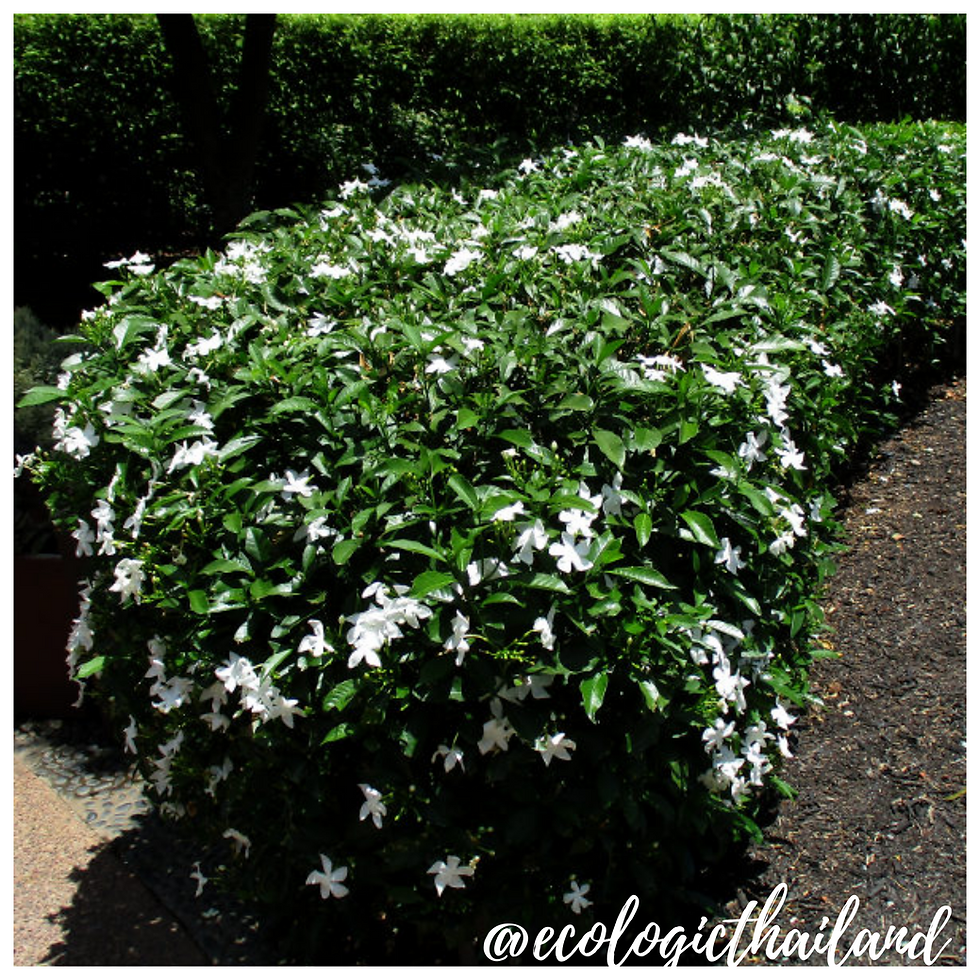Cassava
- Eco-Logic Resort
- Sep 7, 2020
- 3 min read
Updated: Sep 29, 2020
Man Sappalang | มันสำปะหลัง | Manihot esculenta
Family: Euphorbiaceae - Genus: Manihot

Cassava can be found near the entrance of Mount Never-rest and in the area.
Cassava is the edible tuberous root vegetable of the cassava plant (native to South America). . It's also known as manioc. The cassava plant is a woody, perennial shrub. Cassava is eaten when boiled thoroughly. But is mainly used to extract cassava starch, called tapioca.
! The raw tuberous roots and leaves are highly toxic but are edible once properly prepared and cooked.
Cassava is harvested about 8 - 10 months after planting, from November to March.

CASSAVA PLANT
Cassava is a perennial plant, and is extensively cultivated as an annual crop in tropical and subtropical regions for its edible starchy tuberous root, a major source of carbohydrates.

CASSAVA LEAVES
Cassava leaves are green and alternated on the stem.
The leaves are edible, and are a good source of protein.
! The leaves are highly toxic but are edible once properly prepared and cooked.

CASSAVA FLOWERS
There are male and female flowers on a single plant.
The flowers are a gold/yellow color with pink and white
It has 4-5 petals/and is small (ca. 2 cm).

CASSAVA ROOTS
The cassava root is long and tapered, with a firm, flesh in a rind that is about 1 mm thick, rough and brown on the outside. Cassava roots can be 5 to 10 centimetres in diameter at the top, and 15 to 30 centimetres long The flesh can be chalk-white or yellowish.
Cassava roots are very rich in starch
!The raw tuberous roots are highly toxic but are edible once properly prepared and cooked.
CULINARY USES OF CASSAVA
!The raw tuberous roots and raw leaves are highly toxic but are edible once properly prepared and cooked.
Cassava is predominantly consumed in boiled form, but substantial quantities are used to extract cassava starch, called tapioca, which is used for food, animal feed, and industrial purposes.
Cassava can be cooked in many ways. The root has a delicate flavor and can replace potatoes.
It can be made into a flour that is used in breads, cakes and cookies.
In Thailand a popular traditional cassava dish is Chuem, a candied starchy dessert.
The tubers are also used for making tapioca pearls used in other desserts.
and drinks.
The leaves are also edible, but in raw form, the leaf is toxic. When you boil the leaves the poison is neutralized and the cassava is safe to eat.
NUTRITION
100 gram of raw cassava contains:
Energy 160 kcal
Carbohydrates 38.1 gram
Sugars 1.7 gram
Dietary fiber 1.8 gram
Fat 0.3 gram
Protein 1.4 gram
Vitamins
Thiamine (B1) 0.087 milligram
Riboflavin (B2) 0.048 milligram
Niacin (B3) 0.854 milligram
Vitamin B6 0.088 milligram
Folate (B9) 27 microgram
Vitamin C 20.6 milligram
Minerals
Calcium 16 milligram
Iron 0.27 milligram
Magnesium 21 milligram
Phosphorus 27 milligram
Potassium 271 milligram
Sodium 14 milligram
Zinc 0.34 milligram
TRADITIONAL MEDICINAL USE OF CASSAVA
NOTE: please take advice from a doctor if you are planning to use herbal medicine.
CASSAVA ROOT
Alternative practitioners believe that cassava roots can aid in the treatment or prevention of certain health conditions, including:
Arthritis
Cancer
Dandruff
Diabetes
Diarrhea
Hair loss
Infertility
Prolonged labor
Skin infections
CASSAVA LEAVES
The leaves are said to assists in digestion and may help to overcome the constipation.
It also helps to relieve headaches, cold medicine, worms, rheumatism, ulcers, diarrhea and enhance stamina.
INTO THE WILD: a down to earth experience

For guests and visitors to Paksong we organize weekly tours "The Edible Forest" and Foraging weekends: Into the Wild. We work with local guides to take you in the jungle of Paksong. After foraging, we will cook a meal with the ingredients, using bamboo together with you!
Come and join and learn about the abundance of food that nature gives us!
INTO THE WILD!


















Comments